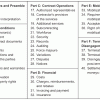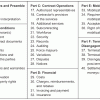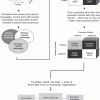Business Transformation Requires Transformational Leaders
Leadership and teaming skills are front and center in times of rapid change. Meet today’s constant disruption head on with expert guidance in leadership, business strategy, transformation, and innovation. Whether the disruption du jour is a digitally-driven upending of traditional business models, the pandemic-driven end to business as usual, or the change-driven challenge of staffing that meets your transformation plans—you’ll be prepared with cutting edge techniques and expert knowledge that enable strategic leadership.
Recently Published
Distressed Projects: Prevention and Intervention Strategies
Whenever the performance of a project falls outside nominal values, it will be judged to be a project in distress and likely to fail unless some intervention strategy brings it back under control. How it got to that state is a question that needs answering. But more important is how it can be returned to a state of normalcy -- if at all.
The 40 Fundamental Clauses in an Outsourcing Contract
A plethora of resources exists that attempts to assist organizations in drafting their outsourcing arrangements. Well-meaning individuals frequently publish, on the Internet, contracts they have developed in their organizations. These, while undoubtedly useful to the writer at the time, are often less useful to others (who are not from the same organization, are not using the same vendor, are not in the same country, do not have the same scope, do not have the same issues but have other issues not addressed, and so on).
The 40 Fundamental Clauses in an Outsourcing Contract
Outsourcing contracts are difficult to prepare. Perhaps that explains why a recent Google search on "IT outsourcing contract" yielded 22.4 million results! Many books and articles on the subject are written by lawyers for lawyers, which makes the language inaccessible to the" legalese challenged," thus presenting a high risk of unintentional noncompliance by both parties. There are also many contracts you can buy sight unseen, which means their particular usefulness for your situation is unknown.
Much has been reported lately about companies and government entities mistakenly releasing consumer records or allowing them to be compromised by malicious third parties.
Candor is an interesting thing. It frees us on the one hand but constrains us on the other -- and so it is with the people in our technology lives. Sometimes we love them, sometimes we hate them. Sometimes they perform well, sometimes they perform poorly. How candid are we about the technology professionals we rely upon so much? How candid are we about the executive teams that depend on them and direct their efforts?
Balancing Competition and Collaboration in Vendor Negotiations
Imagine that you are a CIO responsible for negotiating next year's annual contract with a large software vendor. On the one hand, you are charged with getting the best possible deal for your company from this vendor. On the other hand, this vendor is the only provider of the particular software package that is ideal for your application, and selecting any other vendor would cause a painful and expensive redesign of the software and procedures on your end.
The accompanying Executive Report focuses on the human factor in the business technology relationship. After asking how well you really know the people in your organization, the report takes a look at the important traits -- including the three types of knowledge -- that employees should have and how you should go about finding these types of people.
Balancing Competition and Collaboration in Vendor Negotiations
Negotiations with vendors present many challenges to buyers. Deciding what approach to take and how far you can push to get the best deal before you damage the relationship with the other party is not a simple task, especially in cases where the partners and suppliers are large, powerful organizations with whom you will need to negotiate and work in the future.









